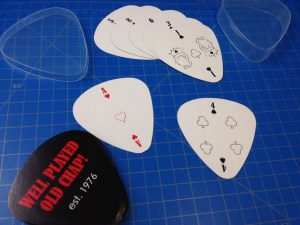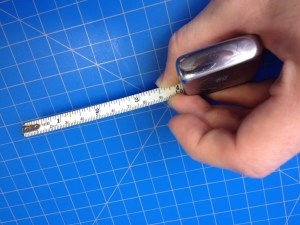Despite me having thousands (probably) of decks of playing cards there is one property they have with very little variance, and that is their rectangularness. Almost every deck of cards ever printed is rectangular, even though you’d think that with modern printing we’d just be making them in every conceivable shape. I’ve still got my hands on a few oddly shaped decks, though, and as I go through them, I think you’ll see that despite them being fascinating, there is a reason we keep the old rectangular design most of the time. (Of course it’s because they’re easier to print, hold, shuffle, and store. You already knew that, but more shapes are fun.)


Of course circular is the most popular, and the one I have the most examples of at 6. It’s the shape that is the most different from the standard rectangle, while still potentially being playable. Most sets use a simple pattern, where the illustration is in the center surrounded by 6 pips around the edge. It’s about as good a design as one could come up with for the shape, but it isn’t particularly easy to hold, both in general and in a way that allows one to see the pips. But on the table they look super cool, and they allow for strange back designs that make them “loved” by novelty toy companies that make things in China. My favorite’s the one with the world on the back, but the oldest one (by Waddingtons) with pink elephants is pretty neat too.


The third most common shape I’ve seen is surprising, but likely the most functional behind the standard. They are made by Umbra, a furniture and home décor company that apparently had some leftover cardboard (I joke, but a surprising number of décor and furniture companies have branded cards) and they’re five inch long, inch and a half wide oblong “capsules” (they have straight sides). This large shape and the ungainly rounded plastic containers they come in make them hard to store and cumbersome to take with you, but the minimalistic design with two pips and a line down the middle allow them to be easily understandable and the tall format with rounded bottoms makes them easy to fan out even while holding large hands. They might not be my first choice but maybe they’re an okay pack for vacations.


And now it’s time for the weird; if you want to be reminded of the wonderful days of summer when you’re dealing a hand there’re flip-flop shaped cards (mine are from Two’s Company, and not the ones currently available online) that are far too big but easy to fan out in your hand since the pips are printed on a part that curves away from the rest of the card. They also strangely have 3 different back designs randomly distributed throughout the cards because they couldn’t be bothered to make decisions with a straight head. And speaking of that there’s the “crooked pack” which introduces two angles into the middle of the cards in what I assume is an attempt to make them easier to fan, but has the side effect of making them impossible to shuffle, and that isn’t helped by the poor quality of their construction. Still, they are probably the most playable deck I’ve mentioned and for that reason they are actually still available (though mine say made in Hong Kong so they might not be exactly the same).


And since Chinese manufacturers tend to not ask questions, there are a ton from there, most coming in cheap clear plastic cases that match the cards’ shape, and the card quality is low enough that they begin to fall apart after a few plays. I’ve got a guitar pick deck that has the pips printed in such a way that you can only play with the deck in one direction (which seems to be upside down) and not very comfortably at that. Then there’s a deck shaped like a football, which literally just has regular playing card faces printed small enough that they fit inside the shape and thus are almost unplayable because there’s no way to hold more that a few and see the values on the card. And I have a heart deck that looks just as bad despite trying to compensate for the new shape.



But the absolutely worst shaped deck I have ever encountered is a little one shaped like a racecar, complete with an east-to-tear triangle for the spoiler. The deck is a master-class in not thinking: the design is too complicated to hold, shuffle, or easily put back in the case. The cardstock used is flimsy and easily tear-able, while the coating makes them slippery when being held. The pips are placed where they are hard to see while fanning the cards, and they are black numbers surrounded by a black circle (yes, all four 9s have the same pips, same for the 8s, etc.), and to make things just that little bit more confusing, they even changed out the regular suits for: helmets, trophies, flags, and wheels. They’re just a disaster, but you can still buy them at party-favor websites if you don’t want anyone at your party to have fun playing cards.


(Now, before the last paragraph here, I’d like to briefly mention a deck that had me fooled. Even though I had previously seen what was inside I still thought that the “Archideck” was a set of different shaped cards because of its “building” -shaped box, but alas, they just have boring pictures of New York buildings on them, and shame on me for being fooled.)


So is there a lesson to be learned from all that? Yes, I think: if you want to play a game, maybe just stick to regular cards, but other shapes are fun to look at and to mess with. If there is a better shape than the rectangle I haven’t found it yet, and I’m starting to think there probably isn’t and we got it right the first time. But, of course I do enjoy all these experimental decks, and getting one out to use every once in a while is still a fun thing to do.































